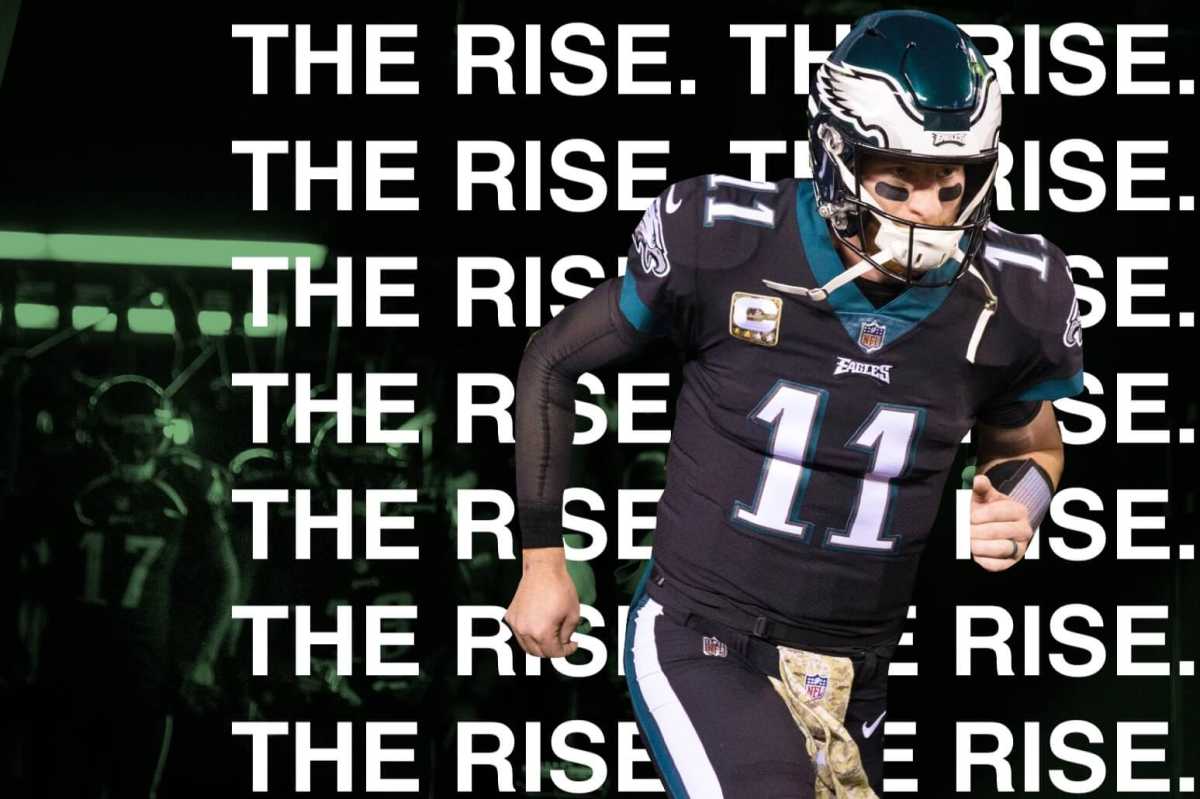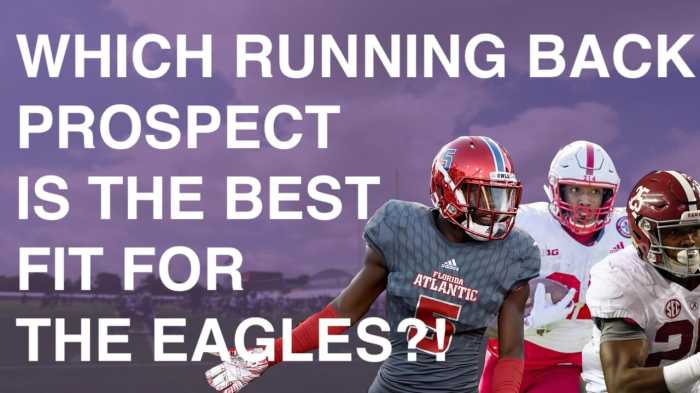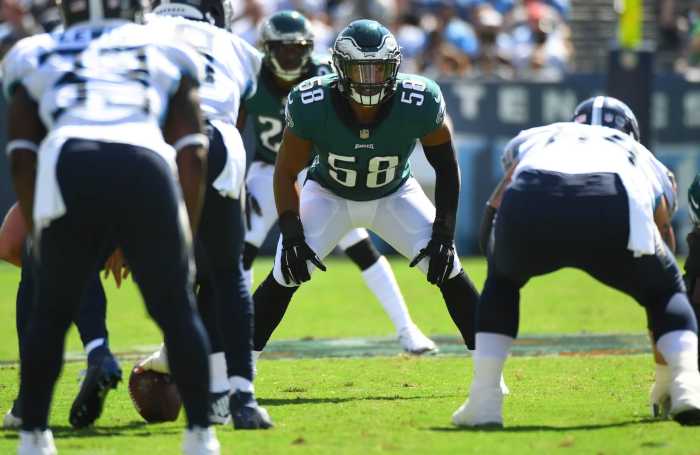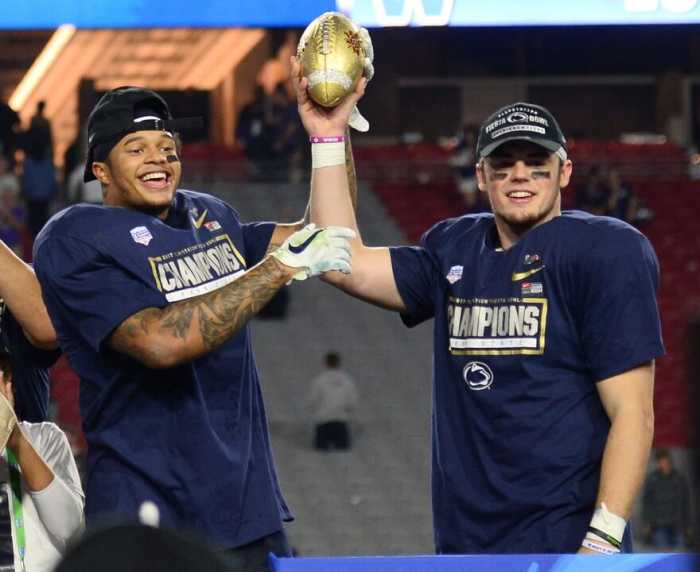The dust has settled after a tumultuous NFL Draft, which has allowed most of us to make some sense of the events that took place this past weekend. Overall, the Eagles had a fairly calm draft: taking care of a few needs, planning for the future and adding to their strengths. There weren’t many flashy selections or shocking reaches, but this class of draftees still had its share of surprises.
Beginning the weekend with seven picks, the Eagles ended up taking five players — OT Andre Dillard, RB Miles Sanders, WR J.J. Arcega-Whiteside, DE Shareef Miller, and QB Clayton Thorson — and trading for DT Hassan Ridgeway. This year’s draft was offense-driven despite being a talent-loaded defensive class. Howie Roseman has said that the team is not done making adjustments to the roster and we may yet the team add pieces to the defensive side of the football. Regardless of the moves to be made in the near future, Philly’s approach to this draft has put forth some definitive statements about the team’s direction for 2019-2020. Namely:
The Eagles are committed to a Carson Wentz lead offense.
Last season amidst quarterback turnover and inconsistent offensive success, there were rumors that Doug Pederson’s offense was more suited to backup Nick Foles’ style of play than the future face of the franchise. 2018 was a difficult year for the young signal caller, coming back from a major injury and suffering others along the way, and Wentz is still learning the nuances of playing quarterback at the NFL level. It’s fair to believe that his adjustment period may not be over and that still has much to learn.
The same could also be said for third-year Head Coach Doug Pederson. Both men will have to work together to form a playbook and scheme that works to their best interests. The Eagles suffered through some coaching turnover on the offense that added to the tumultuous nature of the offense’s production. Even the coaches that remained from the Super Bowl winning season had to get acclimated to new roles and titles.
2019 is the year to set it right. Aside from a change at the wide receivers’ coaching position, the bulk of the offensive coaching staff has remained intact. The team will have an entire offseason to streamline last year’s iteration of the offense and cater it to Wentz’ skill set. This goes for personnel as well.
You could infer the team’s commitment to their young pivot simply by the amount of capital spent on the offensive side of the football. However, it’s not just the quantity of the selection, but the quality that makes the difference. The Eagles made selections that were tailor-made to Wentz’ skill set. Let’s look at Philadelphia’s first three selections in the context of Carson’s play style.
Continued on the next page.
OT Andre Dillard
Generally when NFL franchises spend high first-round selections on quarterbacks for the future, a subsequent high round selection will be used on a left tackle. An investment on keeping the new asset healthy was one the Eagles did not have to make with future Hall of Fame left tackle Jason Peters still on the roster. Watching Wentz suffer through two season-ending injuries with Peters himself struggling to play a full 16-game season, Roseman could wait no longer.
Understanding how Carson’s mobility plays a huge role in the pressure he can put on a defense, Philadelphia went out and got the most athletic left tackle in the class. Andre Dillard is a pass blocking specialist with great base in a variety of pass protection schemes. He uses his quick feet and smooth lower body technique to stay one step ahead of rushers and will need to continue that to keep up with Wentz — who likes to make plays outside of the pocket.
The Eagles could have spent this pick on another deserving left tackle — and there were many left on the board. Particularly, there were options with a more extensive and more accomplished history blocking in running situations. Dillard’s athletic makeup matches what Philadelphia likes to do rushing the football, but so does Cody Ford’s; for example. Not only selecting Dillard but moving up to take him means the Eagles expect to throw the football a lot in 2019 and beyond. Carson will no longer be limited to 20-25 pass attempts a game.
RB Miles Sanders
A good running game will work wonders for any quarterback. However, of all three early selections, I think the selection of Sanders is the least Carson-influenced. Sanders was a guy the entire coaching staff wanted, so they went out and got him. He will absolutely bring a spark to the passing game as a receiver but isn’t known to be a stout pass blocker. It’s not uncommon for rookie runners to have some work to do in that area upon entering the league. I still believe Jordan Howard and Corey Clement will be the go-to option in that facet. Still, there are ways in which Sanders will immediately influence opponents and open up the offense for his teammates.
As a pass-catcher out of the backfield, Sanders is a versatile puzzle piece. At Penn State, he was asked to line up in the slot and out wide as well, which provides Doug Pederson with even more avenues to attack a defense. Wherever he lines up, he will be a great safety blanket for Wentz to grow with. Nevertheless, the young recruit is more than just an outlet underneath for this offense. There are two areas in particular that Sanders brings something to the table that the other backs on the roster simply do not.
Corey Clement deserves every bit of recognition for becoming such a productive pass catcher after essentially being a hand-off exclusive runner at Wisconsin. However, he’s not the speediest third-down back and won’t wow with the separation he gets simply from his burst out of his cuts. Sanders, on the other hand, is lightning quick out of his breaks. Where this will matter most is on out routes. The out route is Carson’s third most-thrown route and one in which he had a 68% completion percentage in 2018. The issue is that these routes only resulted in an 8.5 yard gain on average. That is because, aside from the occasional burst from Nelson Agholor or a broken tackle forced by Golden Tate, no receiver on the Eagles is an immediate threat to turn an out up field and outrun the opposing slot corner. Sanders is, and has proven it.
This also applies to flat routes, which have been a troublesome area for Wentz. Last season he had only a 35% completion rate on such routes. Carson did not have the benefit of Darren Sproles flat route extraordinaire and Clement and Smallwood are lacking the lateral quickness or speed after the catch to really stress opposing defenses. Sanders should be able to apply the same burst he showcases on out routes to flat routes and consistently be a threat to turn a short pass into a long gain.
The second way in which Sanders will influence the passing game requires a tad more explanation. The rookie’s running style is much more patient at the second level than both Corey Clement and Wendell Smallwood. He has the ability to slow play a run in order to suck the linebackers in for an eventual bounce to the outside. This forces the second level of the defense to make a decision.
The first option is to collapse quickly on Sanders and attempt to snuff out any option he has of bouncing runs to the outside. In these cases, Sanders has shown the patience to wait for his blocks to work their magic, or use his unbelievable body control to find small gaps in between opponents and exploit them. Smallwood and Clement have shown the decisiveness and initial burst to slice their way through gaps in the defense, but have generally lacked the patience or the lateral explosion to bounce when the opportunity arises. Josh Adams had almost the opposite issue. He was more than willing to wait for room to the outside only for defenses to force him back into the middle where he looked lost on more occasions than not. While he is capable of gashing the middle of the defense, Sanders generally causes the most damage when allowed to get to space outside the numbers.
Therefore, the better option for defenders is to stay disciplined and maintain spacing in order to wait for Sanders to bounce and make the tackle. Here is where his influence will make the biggest difference for the offense. Those gaps in between linebackers is where this offense makes its money. Those spaces are where Zach Ertz, Dallas Goedert, and Nelson Agholor operate. Those areas are what teams took away from the offense last season when the Eagles couldn’t run the ball well enough to keep defenses honest and Ertz was thrown the ball 15+ times a game. Picture Carson’s interceptions against Dallas and Indianapolis when a linebacker snuffed out a quick pass to Ertz over the middle. The spacing between defenders was tight because they were not worried about Wendell Smallwood or Corey Clement gassing them to the outside. Nelson Agholor was the only player on the offense that could truly outrun the opposition and you simply cannot run 15 reverses a game.
With Sanders, Ertz, Goedert, and Agholor on the field for 3rd and five, defenses will be worryingly pressed to cover all the little gaps in between defenders. This type of horizontal decision making is where Wentz has been at his best in the NFL. While is vertical reads can sometimes be slow or incorrect, he is incredibly quick at diagnosing the lateral movement of a defense. This is evidenced by his 70% completion rate on curl routes, which also happens to be his favorite (54 attempts). You can see the full completion-by-route chart below:
Continued on the next page.



























